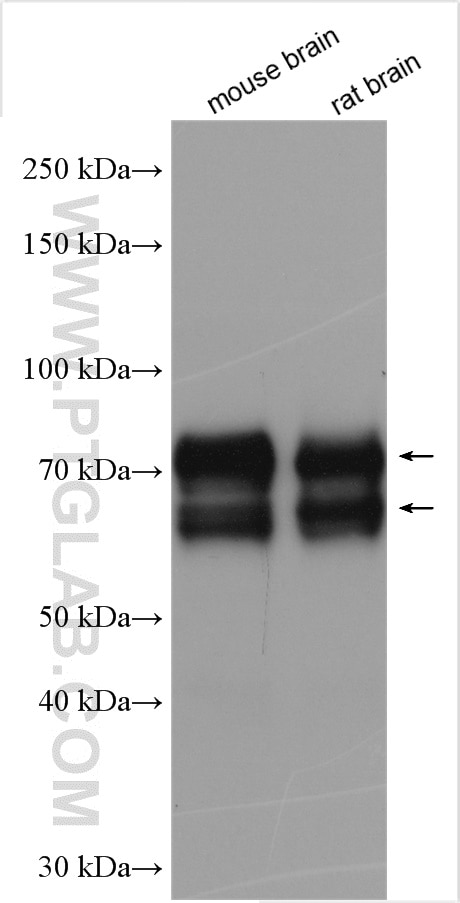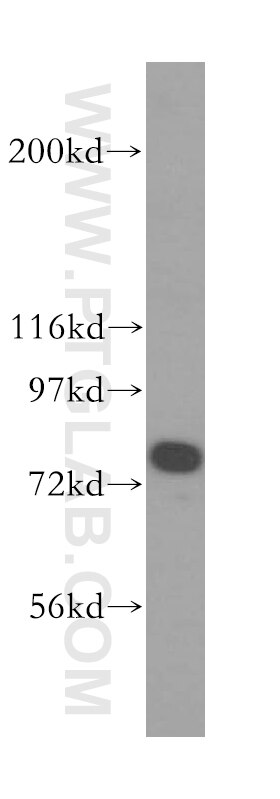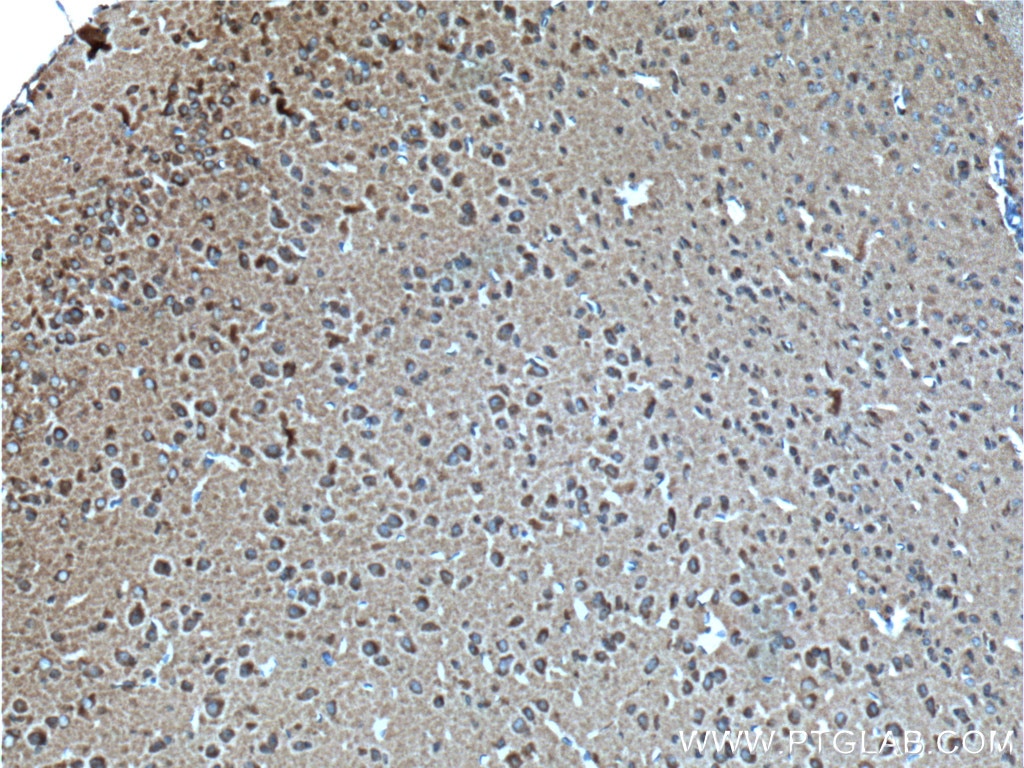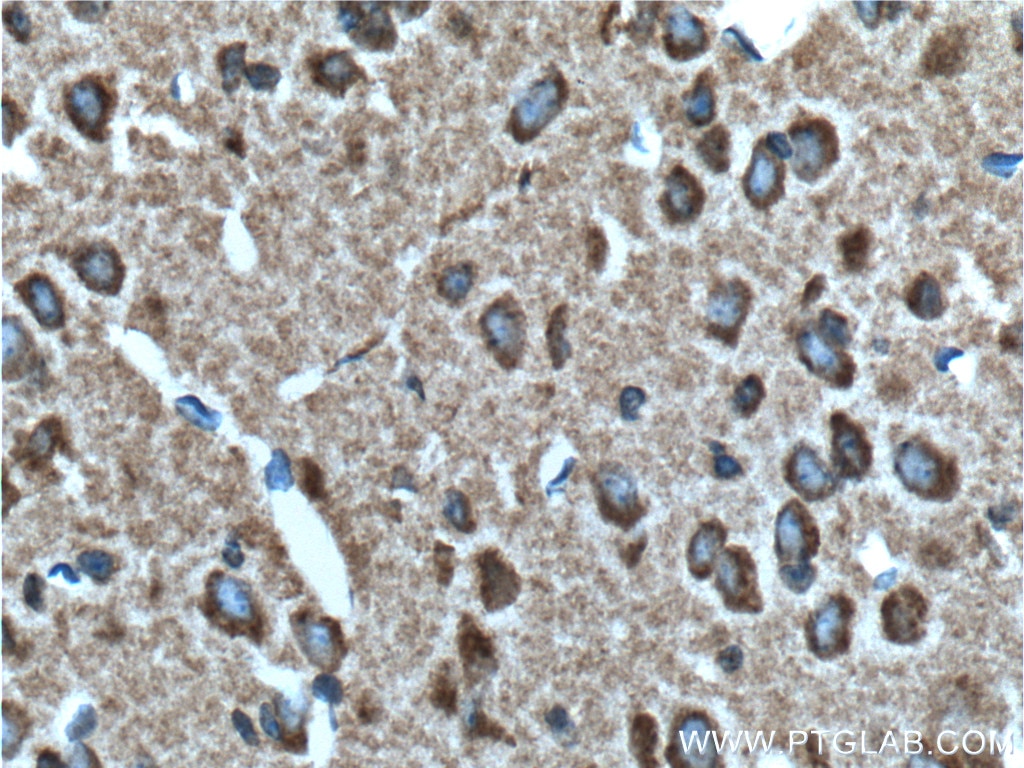Syntaphilin Polyklonaler Antikörper
Syntaphilin Polyklonal Antikörper für WB, IHC, ELISA
Wirt / Isotyp
Kaninchen / IgG
Getestete Reaktivität
human, Maus, Ratte
Anwendung
WB, IHC, IF, ELISA
Konjugation
Unkonjugiert
Kat-Nr. : 13646-1-AP
Synonyme
Geprüfte Anwendungen
| Erfolgreiche Detektion in WB | Maushirngewebe, Maus-Tracheagewebe, Rattenhirngewebe |
| Erfolgreiche Detektion in IHC | Maushirngewebe Hinweis: Antigendemaskierung mit TE-Puffer pH 9,0 empfohlen. (*) Wahlweise kann die Antigendemaskierung auch mit Citratpuffer pH 6,0 erfolgen. |
Empfohlene Verdünnung
| Anwendung | Verdünnung |
|---|---|
| Western Blot (WB) | WB : 1:2000-1:10000 |
| Immunhistochemie (IHC) | IHC : 1:50-1:500 |
| It is recommended that this reagent should be titrated in each testing system to obtain optimal results. | |
| Sample-dependent, check data in validation data gallery | |
Veröffentlichte Anwendungen
| WB | See 5 publications below |
| IHC | See 2 publications below |
| IF | See 1 publications below |
Produktinformation
13646-1-AP bindet in WB, IHC, IF, ELISA Syntaphilin und zeigt Reaktivität mit human, Maus, Ratten
| Getestete Reaktivität | human, Maus, Ratte |
| In Publikationen genannte Reaktivität | human, Maus, Ratte |
| Wirt / Isotyp | Kaninchen / IgG |
| Klonalität | Polyklonal |
| Typ | Antikörper |
| Immunogen | Syntaphilin fusion protein Ag4594 |
| Vollständiger Name | syntaphilin |
| Berechnetes Molekulargewicht | 538 aa, 58 kDa |
| Beobachtetes Molekulargewicht | 70-75 kDa, 65 kDa |
| GenBank-Zugangsnummer | BC035788 |
| Gene symbol | SNPH |
| Gene ID (NCBI) | 9751 |
| Konjugation | Unkonjugiert |
| Form | Liquid |
| Reinigungsmethode | Antigen-Affinitätsreinigung |
| Lagerungspuffer | PBS with 0.02% sodium azide and 50% glycerol |
| Lagerungsbedingungen | Bei -20°C lagern. Nach dem Versand ein Jahr lang stabil Aliquotieren ist bei -20oC Lagerung nicht notwendig. 20ul Größen enthalten 0,1% BSA. |
Hintergrundinformationen
Syntaphilin is a protein selectively expressed in brain. Syntaphilin competes with SNAP-25 for binding to syntaxin-1 and inhibits SNARE complex formation by absorbing free syntaxin-1, and thereby regulates synaptic vesicle exocytosis (PMID: 10707983). The deduced 537-amino acid syntaphilin protein contains an N-terminal proline-rich domain, a predicted coiled-coil domain, a putative C-terminal transmembrane domain, and numerous consensus sites for protein phosphorylation. Whereas the calculated molecular mass of syntaphilin is 58 kDa, the apparent molecular mass of 70-75 kDa is larger than the predicted mass, suggesting a posttranslational modification of syntaphilin (PMID: 9205841; 10707983). An extra band of 65 kDa was also detected by this antibody that may represent an alternative syntaphilin gene product or a stable degradation product (PMID: 10707983; 24457644).
Protokolle
| PRODUKTSPEZIFISCHE PROTOKOLLE | |
|---|---|
| WB protocol for Syntaphilin antibody 13646-1-AP | Protokoll herunterladen |
| IHC protocol for Syntaphilin antibody 13646-1-AP | Protokoll herunterladenl |
| STANDARD-PROTOKOLLE | |
|---|---|
| Klicken Sie hier, um unsere Standardprotokolle anzuzeigen |
Publikationen
| Species | Application | Title |
|---|---|---|
Sci Rep Identification of a novel interaction of FUS and syntaphilin may explain synaptic and mitochondrial abnormalities caused by ALS mutations. | ||
Mol Brain Disrupted-in-schizophrenia 1 (DISC1) and Syntaphilin collaborate to modulate axonal mitochondrial anchoring. | ||
Brain Res Miro1 provides neuroprotection via the mitochondrial trafficking pathway in a rat model of traumatic brain injury. | ||
Bioeng Transl Med Photobiomodulation augments the effects of mitochondrial transplantation in the treatment of spinal cord injury in rats by facilitating mitochondrial transfer to neurons via Connexin 36 | ||
Neuroscience Armcx1 reduces neurological damage via a mitochondrial transport pathway involving Miro1 after traumatic brain injury | ||
Neurochem Int 3-Nitrotyrosine shortens axons of non-dopaminergic neurons by inhibiting mitochondrial motility |





